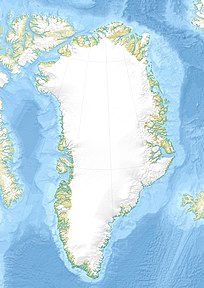Qaarsut
| Qaarsut (the rocks) | ||
|---|---|---|
| K'aersut | ||
| Qaarsut seen from the air (2007) | ||
| Commune | Avannaata Communia | |
| District | Uummannaq | |
| Geographical location | 70 ° 44 ′ 0 ″ N , 52 ° 39 ′ 0 ″ W | |
|
|
||
| Residents | 174 (January 1, 2020) |
|
| founding | 1870 | |
| Time zone | UTC-3 | |
| particularities | oldest mine in Greenland | |
Qaarsut [ ˈqɑːsːutˢʰ ] (according to the old spelling K'aersut ) is a Greenlandic settlement in the district of Uummannaq in the Avannaata Kommunia .
location
Qaarsut is located on the north coast of the Nuussuaq peninsula on Uummannap Kangerlua . The place name refers to the mountains towering behind the place with the mountain Qilertinnguit . The nearest town from Qaarsut is the district capital Uummannaq, 19 km to the east .
history
Qaarsut was already inhabited before the colonial era. Around 1780, some people lived there only occasionally in the summer. Even around 1850 Qaarsut was only a summer place. Around 1865 a Dane was hired in Qaarsut to catch yarn. He lived there with his Greenlandic family and later other people moved to Qaarsut. It is not known whether the place was given Udsted status. Presumably this happened in the late 1870s.
From 1911, Qaarsut was a separate community within the colonial district of Uummannaq, to which the nearby residential area Qaarsuarsuk still belonged. Due to the coal mining in Qaarsuarsuk, the economic situation of the community was extremely good. The parish council had three members and the parish was part of the 8th county council of North Greenland.
In 1915 Qaarsut had 67 residents. There were twelve Greenlandic houses in the village, one already dilapidated house for the Udsteds administrator with two rooms and a kitchen, a provisions store with a shop in the attic from 1903, a powder house from 1905 and two Greenlandic bacon houses from 1877. The school chapel was from 1911 and a 53 m² Greenland House. Sixteen hunters, a fisherman, the Udsteds administrator, a catechist and a midwife worked in Qaarsut.
In 1922 a new Udsteds administrator's apartment was built and in 1924 the place received a packing house. In 1930 Qaarsut had 86 residents. In 1946 a new school chapel was built. In 1950 there were already 137 people living in the village. In 1960 the number rose to 211 and in 1970 Qaarsut had 257 inhabitants. From then on the population decreased again. Eight mummies were found in the long-abandoned Inuit settlement of Qilakitsoq, 21 km southeast of Qaarsut, in 1972 and are now exhibited in the Greenland National Museum in Nuuk .
In 1950 Qaarsut was incorporated into the Uummannaq community . In 2009 Qaarsut became part of the Qaasuitsup Kommunia . Since 2018 the place belongs to the Avannaata Kommunia .
economy
The economic structure in Qaarsut is characterized by hunting, fishing and the operation of the airport. Mainly halibut are caught, roe processed and seals hunted. Through the airport, Qaarsut is also visited by tourists who mainly want to visit Uummannaq or Qilakitsoq.
Infrastructure and supply
Qaarsut has no permanent port facilities, but a port can be built north of the airport. The airport Qaarsut provided by the Airports Ilulissat and Upernavik is served is located east of the town. It is rather unusual for a Greenland village to have an airport. However, since there was no place on the island of Uummannaq to build the city airport, it was built in Qaarsut in 1999, from where there is a helicopter connection to the Uummannaq heliport . In summer, traffic with the surrounding area takes place by boat and in winter with snowmobiles and dog sleds across the frozen fjord.
Nukissiorfiit supplies the place with electricity via a diesel power station and with fresh water via surface water, while the heat supply is ensured by oil stoves. The wastewater is discharged into the sea and garbage is stored on the landfill to the west. TELE Greenland is responsible for the telecommunications supply.
Development
Almost 30 students are taught from 1st to 9th grade in the Atuarfik Kaali school chapel . A Pilersuisoq branch sells goods to the villagers. Medical care is provided by an infirmary. There is also a community workshop, an assembly building and a service building, as well as a soccer field. Four buildings from the 1920s and 1930s are classified as worthy of preservation.
Sons and daughters
- Enok Zeeb (1882–1925), Provincial Councilor
- Pavia Nielsen (* 1936), politician (Siumut)
Population development
The population of Qaarsut fluctuated around 220 for a long time before the population began to decline sharply at the turn of the millennium.

Web links
Individual evidence
- ↑ Map with all official place names confirmed by Oqaasileriffik , provided by Asiaq
- ^ A b Alfred Bertelsen , Hother Ostermann : Beskrivelse af Distrikterne i Nordgrønland: Ũmánaĸ district. De grandson Bopladser. Kaersut . In: Georg Carl Amdrup , Louis Bobé , Adolf Severin Jensen , Hans Peder Steensby (eds.): Grønland i tohundredeaaret for Hans Egedes landing (= Meddelelser om Grønland . Volume 60-61 ). tape 1 . C. A. Reitzel Boghandel, Copenhagen 1921, p. 400 ff . ( Digitized in the Internet Archive ).
- ^ A b c Jens Christian Madsen: Udsteder og bopladser i Grønland 1901-2000 . Atuagkat, 2009, ISBN 978-87-90133-76-4 , pp. 170 f .
- ↑ a b c d Qaarsut at qaasuitsup-kp.cowi.webhouse.dk
- ^ Qaarsut in Den Store Danske
- ↑ Population of Qaarsut 1977–2020 at bank.stat.gl




